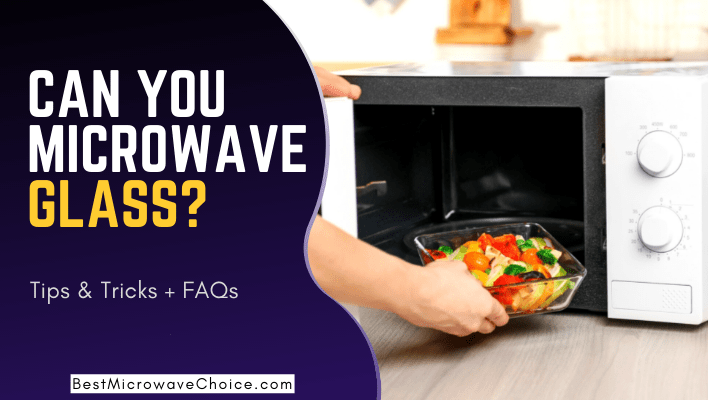The leftovers from the last dinner are generally stored in the refrigerator in a container. Glass is one of the most common food storage containers, so can you put glass in the microwave?
It’s easy to assume that all glass is microwave safe, but that isn’t always the case. Some types of glass aren’t built to withstand the high temperatures needed for microwave and fried cooking.
Continue reading to find out if you can microwave a glass container and how to microwave it safely.
Can You Microwave Glass?
People request that glass containers, cups, and dishes not be used in the microwave because of safety concerns. Even though most glass varieties can be microwaved safely in a kitchen appliance, you can do your tests.
Some companies label their microwave-safe glass dishes, mugs, or containers, while others do not. Follow these procedures if you’re unsure whether or not you can properly microwave glass containers or plates.
Here’s a quick technique to see if your glass containers and dinnerware are safe to microwave:
Step 1: Pour half a cup of water into a microwave-safe cup. Fill the cup to roughly three-quarters of capacity with water.
Step 2: Take the glass dish you want to test to determine if it can go in the microwave. Place the plate and cup side by side in the microwave. If there isn’t enough room on the dish, add the cup of water on top.
Step 3: Microwave the glass dish and the cup for 30 seconds each. After that, you must do a touch test to compare the results.
The test dish absorbs a lot of heat when the water in the microwave-safe cup is cold and the test dish is hot. The test dish will not work in a microwave because of this.
On the other hand, the dish will not absorb the heat if the water is hot, but the dish is cold. That means you can use the microwave-safe test plate.
Related: Can you microwave parchment paper?
Tips to Microwave Glasses
Not all glass containers, cookware, or plates are created equal. Take the following heating and safety precautions into account when microwaving a glass container:
- Only use high-quality glassware from well-known manufacturers. If you’re going to microwave a glass container, dish, or cup, make sure the maker says it’s microwave safe.
- Test glassware that hasn’t been properly labeled as microwave safe. Before microwaving a meal in a glass dish that isn’t labeled as a microwave-safe container, perform the test outlined above.
- Check to discover if you can use colored glass in the microwave. If you plan to use the colored glasses in the microwave, make sure they are microwave safe. Otherwise, the color may leach into your food, rendering it unhealthy to consume.
- Be careful not to overheat glass containers when microwaving them. The glass that has been overheated may cause mishaps or damage to your cookware or appliance. Cook for 2 minutes at a time, stirring every 2 minutes.
- Microwaving metal-decorated glass is not recommended. Microwaving glass with metal ornaments is not recommended since the metal can spark and ignite, resulting in damage or a fire.
- Microwaving glass with air pockets or small bubbles is not recommended. Microwavable glass with little air bubbles or air pockets within is not safe to use in the microwave. The trapped air inside the glass will heat up and expand quickly, cracking or shattering the glass.
- Microwaving cold glass is not recommended. If the glass dish was recently retrieved from the refrigerator or freezer, allow it to come to room temperature before exposing it to heat. When cold glass is directly exposed to strong heat, it cracks.
- Don’t pile too much food on the table. If a dish is overfilled with food, the microwave’s heating ability will be diminished. The meal will be heated inconsistently, resulting in hot and cold spots.
- Microwaving a similar item is an option. It’s best to comparable microwave items when microwaving food in glassware. Foods require different cooking times, temperatures, and techniques. Heating materials with various flavors or textures may produce an off-flavor or texture. To avoid such problems, stick to similar items and ensure that all of your microwaved meals are delicious.
- Stop and stir it around. When microwaving food in a glass container, use short intervals of time. Between each time interval, stir the food in the glass dish to spread the heat uniformly across the dish, facilitate even cooking, and reduce overall microwave time.
- Reheat the food until the appropriate internal temperature is reached. Warmed foods should be reheated in the microwave until they are no longer in the danger zone. The food must reach a minimum internal temperature of 165 degrees Fahrenheit before serving (74 degrees Celsius).
Related: Is it safe to microwave paper plates?
How long can you microwave glass?
The type of food or beverage that needs to be heated affects the answer. Microwaving for 60 seconds will suffice for a cup of water, tea, or coffee. When it comes to food, though, you may need to microwave it for up to 2 minutes.
Although the glass is microwave safe, it can shatter or split if heated for more than 120 seconds.
If the food is still not thoroughly heated, remove the dish from the heat and give it a vigorous toss. Stirring helps distribute heat evenly throughout the meal and ensures it cooks evenly.
Continue heating for another 120 seconds after stirring. To uniformly disperse the heat across the entire dish, use brief time intervals and stir the meal in between each timeframe.
How do I know if the glass is microwave-safe?
Surprisingly, there are a few different ways to determine whether or not something is microwave-safe. To determine if your glass container can be microwaved, try the following:
Option 1: Take a look at the label.
Examining the glassware is the first and most crucial step in evaluating whether or not your container can be microwaved.
Flip the container over and examine the text on the bottom to do so.
A label on the bottom of a glass that says “Microwave Safe” indicates that it is compatible with microwave ovens.
If you see this label, you can start heating/reheating the jar in the microwave straight immediately.
If the microwave ability of the material isn’t mentioned, proceed on to the next option.
Option 2: Perform a test run.
Perform a test run if you’re not sure if your container is microwave-safe by following these steps:
Step 1: Raise the temperature.
Increase the power of your microwave to its maximum setting. Depending on the brand and type of your microwave, this approach may vary. However, in most circumstances, the maximum power option is used by default.
Step 2: Add the water.
Select a microwave-safe cup and fill it with three-quarters full of water after increasing the heat. Once you’ve finished, place the glass container and the cup of water in the microwave.
It’s critical to remember that water should not be put into the container. You can place the cup of water next to it in smaller glass containers.
However, if you’re working with a larger glass container, you can microwave the cup on top of it.
Related: Can you microwave tupperware?
Step 3: Set a time.
Set the timer for one minute after placing the glass container and cup of water in the microwave.
Step 4: Examine the results.
After one minute, check if the glass container has heated but not the water. If you see this, it means your container isn’t microwaving safe.
Microwaving the glass container is possible if it is cold and the cup of water is hot.
It may feel warm in the center if you place the cup of water on top of the container.
Can Glass Go in The Microwave?
Yes, most glass containers can go in the microwave. Glassware is chemically inert, which means that no chemicals will react with the food inside.
Rather than other materials such as plastic, glass could be a great way to keep your food warm in the microwave. However, there are a couple of exceptions to be aware of.
FAQs
Conclusion
So, to sum up, can you put glass in the microwave? Yes, Microwave-safe glass cookware, dishes, and utensils are common. Even though glass has a high heat threshold and will not melt in standard microwave ovens, decorations and poor glass quality are an issue.
Glass with metal ornamentation or small air holes in the composition is not recommended. Metal can generate sparks in the microwave, and heat causes air bubbles to expand, shattering the glass.
Choose glassware from recognized manufacturers for the best performance and results. The following are the best microwave-safe containers to add to your cookware collection.
According to the previous directions and assessments, you can only microwave glass safely if it is clearly labeled as such. On the other hand, the microwave-safe glass may crack or shatter if used while overheated or cold.
As a result, ensure that you follow all of the following rules to ensure your complete safety. If you follow this guide, you should be able to securely microwave glass anytime.
Recommended Posts:
Best Microwave – Reviews & Buyer’s Guide
Best Microwave For Seniors– Reviews & Buyer’s Guide
15 Best Countertop Microwave – Reviews & Buyer’s Guide

Hey! I’m Camila Carter, a dedicated writer of this beautiful blog. Here, I write to provide you the unbiased reviews and buying guides for the very best of microwaves found in the market. I hope you love to read my articles as much as I love to write them for you.




